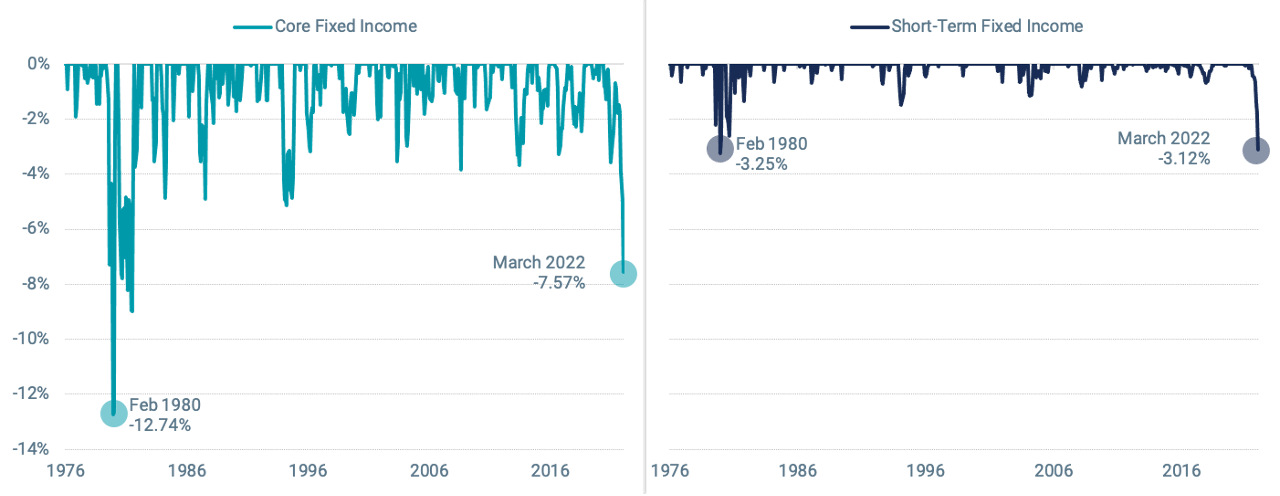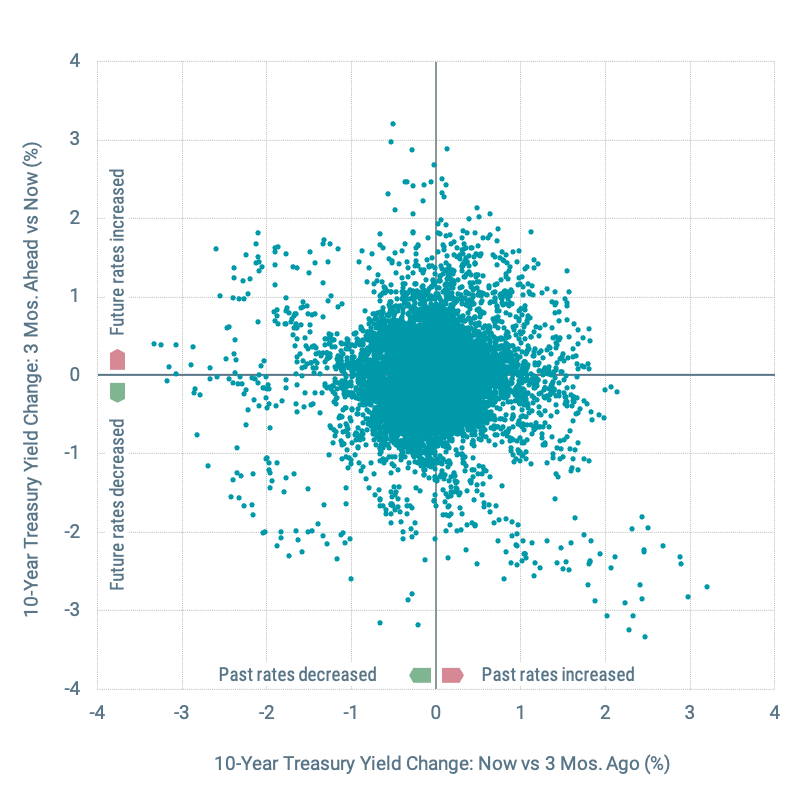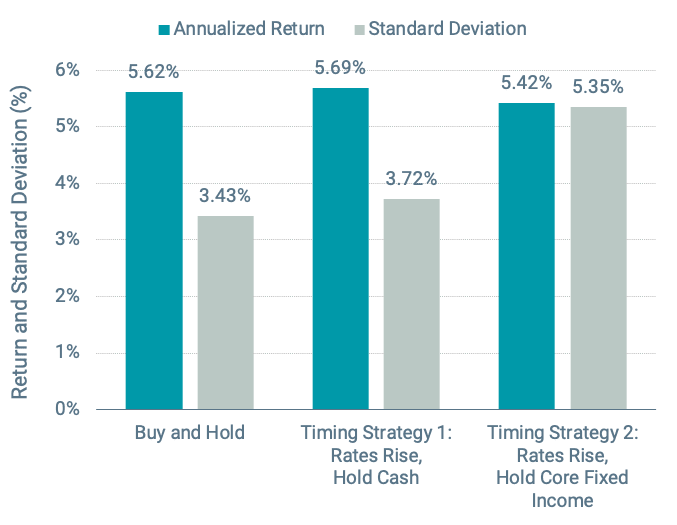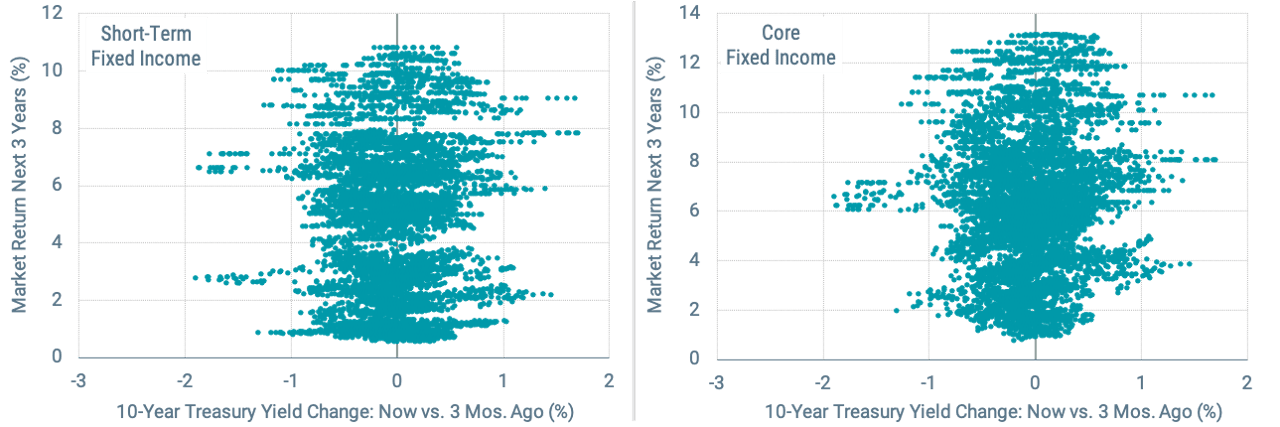Why Yesterday's Rising Rates Don't Guarantee Poor Bond Returns Today
While 2021 offered nearly the best of times for value investors, 2022, to date, is offering some of the worst of times for fixed-income investors. Rising rates have brought falling bond prices and returns across most segments of the U.S. fixed income market have been sharply negative in 2022.
Core fixed income is down -9.50% in 2022 through April. Short-term fixed income has fared better given its lower sensitivity to changing rates, but it is still down -3.01%. These returns are historic, presenting tax-loss harvesting opportunities that are typically reserved for equity allocations.
In Figure 1, we put the recent period in historical context. We present historical drawdowns, measured by the drop in returns since the last peak value, for both core and short-term fixed income through March. We’ve not seen losses like these since the early 1980s. With the U.S. equity market down in similar magnitude to core fixed income at -13.78% year to date, core bonds have offered little help over the period in softening volatility within a total portfolio of stocks and bonds.
Figure 1 | Historical Drawdowns in the U.S. Fixed Income Market

Data from 1/30/1976 – 3/31/2022. Source: Bloomberg. Core Fixed Income is represented by the Bloomberg U.S. Aggregate Bond Index, which tracks the performance of the U.S. intermediate-term investment-grade bond market. Short-Term Fixed Income is represented by the Bloomberg U.S. Government/Credit 1-3 Year Index, which tracks the performance of Treasury and agency securities and publicly issued U.S. corporate and foreign debentures and secured notes with maturities of 1-3 years. Past performance is no guarantee of future results.
Make no mistake, these results are disappointing for investors. And it’s hard to blame them for wondering if bonds can still provide the ballast they expected in their portfolios or whether they might be better off holding another asset, such as cash.
We can’t say with certainty whether rates will keep going up or will fall. We do know that allowing anxiety over short-term conditions to drive asset allocation changes also has the potential to disappoint.
It’s useful to zoom out from what’s happening at the moment to consider the broader perspective. If your fixed-income allocation was appropriate just a few months ago, is it less appropriate now that bonds generally have higher yields? Higher yields represent lower prices today, but higher returns later since bonds must still mature at their par values.
In this article, we present results from a few studies designed to help investors grapple with these questions and explore their implications for portfolios. We examine what recent changes in rates might tell us about rates going forward, whether this information can help investors improve outcomes or if staying the course is the prudent approach.
Future Bond Yields Are Anyone’s Guess
Predicting whether bond yields will go up or down has challenged researchers and investment practitioners since the early days of bond investing. Many have tried, and many have failed to find a reliable predictor of future changes in rates.
Some might assume that persistent inflation and aggressive tightening of monetary policy would continue to exert upward pressure on bond yields. After all, these same conditions contributed to rising yields over the past few months. But history shows a weak relation between recent changes in yields and the path of yields to follow.
In Figure 2, we plot changes in yields over the last three months against changes over the next three months for each day going back to 1976. We see no observable pattern.
In many instances, rates increased over the past three months and then continued to increase over the following three months. In many other examples, rates went the other direction and fell over those next three months. We see similarly noisy outcomes following periods when rates fell.
Figure 2 | Past Changes in Yield vs. Future Changes in Yield

Data from 1/15/1976 – 3/24/2022. Source: Bloomberg. Yield is a rate of return for bonds and other fixed-income securities. Past performance is no guarantee of future results.
In other words, past yield increases do not appear to predict future yield increases. We cannot say yields have been increasing and will continue to increase. The chances of rates going down (or staying relatively flat) would appear to be about as good as the chances that rates continue to go up.
Future yield changes cannot be predicted with any reliability because today’s yields already reflect investors’ expectations collectively. Yields will change as new information is presented to the market, and what that will be is anyone’s guess.
Time to Jump?
There are undoubtedly still investors that believe they are better off today by taking a temporary jump out of fixed income. But this may not prove to be true.
We set up an experiment to compare two timing strategies that shift investments between core fixed income and one-month U.S. Treasury bills (i.e., our proxy for cash) against a strategy that holds a steady combination of core fixed income and T-bills. We ran the analysis from 1976 through the first quarter of 2022.
Figure 3 presents our three hypothetical strategies. The first is the Buy and Hold strategy of core fixed income and T-bills. Timing Strategy 1 looks at the change in the 10-year Treasury yield at the end of each quarter and invests in core fixed income if rates fell or T-bills if rates rose.
This simple strategy moves to a “risk-off” position after each period rates rose and attempts to benefit if rates continue to rise. Timing Strategy 2 takes the opposite approach and invests in core fixed income after rates rose and T-bills after rates fell. This strategy attempts to benefit from rates reverting.
Over the sample, the number of quarters when rates rose and fell was about even, and so on average, each timing strategy is invested in about 50% core fixed income and 50% T-bills. The Buy and Hold strategy matches this split between each asset and maintains it throughout the period.
Figure 3 | Core Fixed Income: Buy-and-Hold vs. Yield-Based Timing Strategies

Data from 4/1/1976 – 3/31/2022. Source: Bloomberg. Core Fixed Income is represented by the Bloomberg U.S. Aggregate Bond Index Hypothetical illustration only. Past performance is no guarantee of future results.

We see from the results that each strategy has similar performance over the sample period. However, Timing Strategy 1 has a modest increase in volatility versus the Buy and Hold strategy, while Timing Strategy 2 comes with significantly higher volatility.
Our experiment offers no evidence that attempting to time the market based on recent changes in yields can help investors improve performance outcomes and may result in unnecessary volatility and higher transaction costs.
In Figure 4, we show results from a similar study that may be more relevant for investors who choose to invest in shorter-duration fixed income. In this scenario, we replace core fixed income with short-term fixed income.
Figure 4 | Short-Term Fixed Income: Buy-and-Hold vs. Yield-Based Timing Strategies

Data from 4/1/1976 – 3/31/2022. Source: Bloomberg. Short-Term Fixed Income is represented by the Bloomberg U.S. Government/Credit 1-3 Year Index. Past performance is no guarantee of future results.
All other aspects of the experiment are consistent with the previous one, shifting the allocation in the timing strategies between short-term fixed income and T-bills based on changes in yields in the prior quarter. The takeaway is no different. Again, we find no benefits from the timing strategies versus the buy-and-hold approach.
Consider also that simply holding 100% core fixed income over the period generated higher compound returns than all six hypothetical strategies, albeit with higher volatility. Put simply, there’s still no free lunch in investing.
Be Wary of Taking the Long View
To find the bright side in all of this, we can look to longer-run returns for a useful reminder of the role bonds can play in a long-term portfolio. In our final study, we examined the relation between the past 3-month change in yield and the performance of core and short-term fixed income over the subsequent 6-, 12- and 36-month periods.
Looking out at longer return periods, as opposed to just returns shortly after we see rates rise or fall, we found that there were generally far more positive return periods than negative. We also found fewer negative periods as the time horizon extended.
For simplicity, we present only the 36-month result in Figure 5. Over this horizon, all return observations are positive regardless of whether rates rose or fell in the prior period.
Figure 5 | Past Changes in Yield vs. Next 3-Year Market Returns

Data from 1/1/1986 – 3/24/2022. Source: Bloomberg. Short-Term Fixed Income is represented by the Bloomberg U.S. Government/Credit 1-3 Year Index. Core Fixed Income is represented by the Bloomberg U.S. Aggregate Bond Index. Past performance is no guarantee of future results.
What each of these studies illustrates is that, while we can’t predict whether yields will continue to rise or whether they will fall, what’s important is investors remember why they invested in bonds in the first place. The exposure and duration one had in their portfolio before rates began to rise is still probably a reasonable default position. Jumping out of fixed income and into cash or taking a large shift in duration now based on what’s happened over the past few months does not guarantee that a portfolio will fare any better. Trying to avoid the worst of times today might just mean you miss out on the best of times to come.
This material has been prepared for educational purposes only. It is not intended to provide, and should not be relied upon for, investment, accounting, legal or tax advice.
Investment return and principal value of security investments will fluctuate. The value at the time of redemption may be more or less than the original cost. Past performance is no guarantee of future results.
Diversification does not assure a profit nor does it protect against loss of principal.
Index performance does not represent the fund's performance. It is not possible to invest directly in an index.